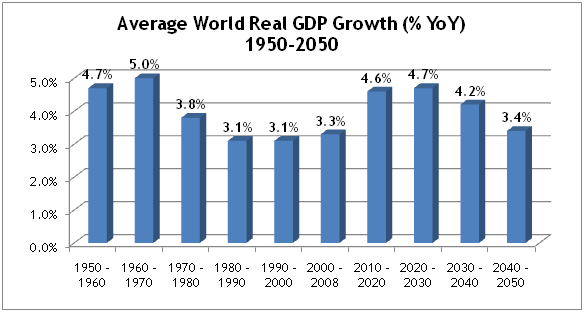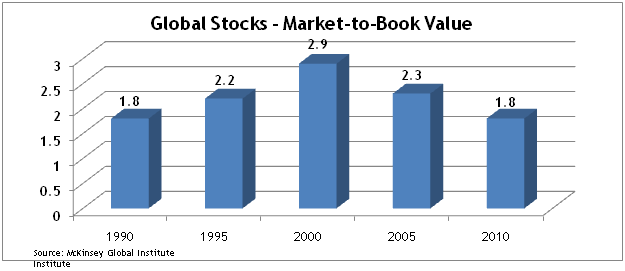The Global "Old Normal"
by Michael Nairne, Tacita Capital
Investors can be excused for their preoccupation with short-term Investment results. Amidst a cascade of dismal economic news, the trauma of a precipitous fall instock pricesand the overhang of a decade-long drought in equity returns,the idea of "taking a long-term view", to many, seems hopelessly pollyanna-ish. Yet, long-term planning has never been more essential. Aging "Baby Boomers"today are grappling with retirement funding challenges that span multiple decades at a juncture where interest rates are atdismally low levels not seen since World War II.
Fortunately, just as the excessive optimism of the tech boom was so misguided at the turn of the millennium, the excessive pessimism of today's "new normal" may be similarly misplaced. According to a comprehensive report by Citi Investment Research and Analysis (CIRA), global GDP growth over the next several decades is likely to enjoy a pace not seen since the post WWII reconstruction and growth boom of the 1950's and 1960's. This faster growth is illustrated in the following graph which compares the annual average world real GDP growth for the decades since 1950 with CIRA's forecasts for the coming four decades.


The 4.6% and 4.7% annual real GDP projections forthis and the next decade, respectively, harken back to the 4.7% and 5.0% growth rates after WWII.
Capital investment, technological imitation, institutional development, human capital availability and industrialization were the key factors in the post WWII boom. Notwithstanding the strong real annual GDP growth rate of 3.9% in the US from 1950 to 1973, it was the 9.3% and 5.5% respective annual growth rates of Japan and the European Union-15 that really lifted world GDP growth.
These same fundamental drivers of growth are at work again in the emerging economies and this is expected to replicatethe brisk global growth achieved after WWII. In particular, CIRA forecasts that developing Asia will continue its ascent in the world economy. Developing Asia grew from 14% of real world GDP in 1990 to 27% in 2010 – a nearly doubling of its share of global GDP - and is forecast to reach 44% of real world GDP by 2030.
The CIRA is not alone in projecting more robust long-term global growth. The Conference Board Global Economic Outlook 2011 has forecast a 4.4% real annual growth in world GDP over the next decade while Goldman Sachs has projected a 4.1% real annual growth rate over the next twenty years. In general, the developed nations are forecast to expand at a tepid pace while emerging markets grow robustly. As emerging economies become a bigger share of the world economy, their faster growth accelerates total world GDP growth.
Long-term GDP growth is ultimately a key determinant inthe growth in corporate earnings which, in turn, drive stock price appreciation and dividend increases (See our Commentary – The Real Deal – at http://www.tacitacapital.com/?q=node/29.) For example, during the period 1991 to 2010 when the world real GDP grew by a more moderate 3.2% per annum, the real price appreciation of the MSCI All Country World Indexwassimilar at 2.9% per annum. Hence, an increased real annual growth rate for the global economyof 1.0% to 1.5% per annum in coming decades would, all other things being equal, enhance real capital appreciation by an equivalent amount.
Economic growth is only one part of the return equation. One of the lasting lessons of the tech boom is that stock returns are highly dependent onthe valuation at the point of entry. Fortunately, according to a recent report by McKinsey Global Institute global stock valuations have fallen over the past decade to a level not seen since 1990. This is illustrated in the following graph which compares market-to-book value ratios for global stocks for selected years from 1990 to 2010.

Valuations skyrocketed in the 1990's as the "new era" paradigm and tech bubble propelled prices to manic levels. By 2000, investors were prepared to pay $2.90 for every $1.00 of book equity of global stocks. Due the tech bust and the crunch of the global credit crisis, valuations have since been in constant decline. They have now returned to the fairly priced levels of 1990 – not cheap, but not expensive either.
Reasonable stock valuations andfaster world economic growth offer the potential for higher real returns from global equities. Based on assumptionsthat reflect brisk global growth (see Appendix I), we have forecast a long-term, expected real total return from global stocks of 6.3% per annum - only modestly below the 6.6% annual real return of U.S. stocks since 1926. Importantly, this expected return reflects an equity portfolio that is invested globally including emerging market stocks.
With the current fixation on the gloomy "new normal" in the US and Europe, many investors are overlookingthe full global picture. The drivers that propelled post WWII growth to vigorous levels have emerged again. Certainly, the world economy will be subject to the normal dynamics of the business cycle,swinging between periods of contraction and expansion. Over the longer-term, however, these forcescreate the potentialof a global "old normal" of resurgent growth and for patient investors, the prospect of higher realreturns from stocks globally than has existed for several decades.
September 30, 2011
Tacita Capital Inc. ("Tacita") is a private, independent family office and investment counselling firm that specializes in providing integrated wealth advisory and portfolio management services to families of affluence. We understand the challenges of affluence and apply the leading research and best practices of top financial academics and industry practitioners in assisting our clients reach their goals.
Tacita research has been prepared without regard to the individual financial circumstances and objectives of persons who receive it and is not intended to replace individually tailored investment advice. The asset classes/securities/instruments/strategies discussed may not be suitable for all investors and certain investors may not be eligible to purchase or participate in some or all of them. The appropriateness of a particular investment or strategy will depend on an investor's individual circumstances and objectives. Tacita recommends that investors independently evaluate particular investments and strategies, and encourages investors to seek the advice of a financial advisor.
Tacita research is prepared for informational purposes. Neither the information nor any opinion expressed constitutes a solicitation by Tacita for the purchase or sale of any securities or financial products. This research is not intended to provide tax, legal, or accounting advice and readers are advised to seek out qualified professionals that provide advice on these issues for their individual circumstances.
Tacita research is based on public information. Tacita makes every effort to use reliable, comprehensive information, but we make no representation that it is accurate or complete. We have no obligation to inform any parties when opinions, estimates or information in Tacita research changes.
All investments involve risk including loss of principal. The value of and income from investments may vary because of changes in interest rates or foreign exchange rates, securities prices or market indexes, operational or financial conditions of companies or other factors. There may be time limitations on the exercise of options or other rights in securities transactions. Past performance is not necessarily a guide to future performance. Estimates of future performance are based on assumptions that may not be realized. Management fees and expenses are associated with investing.












